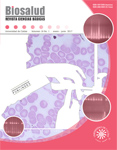Authors
Abstract
Medical language, like all scientific language, does not pursue aesthetic, creative, leisure and recreational purposes as would be the case in literary language, but informative, educational and communication purposes. Eponyms and the different types of abbreviations (abbreviations, acronyms, and symbols) have been part of the language of humanity for over twenty centuries and are especially abundant in the languages for both specialties in medicine, and other sciences. On the common and popular language, these elements have been part of the language since ancient times, and are especially abundant in the medical-scientific languages. Normally are used as a resource to honor, to save time and save space, when its content is perceived well, notoriously it reveals a saving in medical communication; not to use them, in each case would have to make a relatively large exposure or description of the disease or of the sign in question. However, they can cause communication problems between professionals of different levels of care, due to their imprecision and their lack of international equivalence, which may lead to confusing the reality they are trying to describe since the same term or abbreviation could have different meanings, which can lead to misinterpretations with potentially serious consequences. This article discusses the reasons for their existence which define their construction and uses, problems of its use in medical scientific communication at present are also described.
References
2. Gutiérrez Rodilla. Lo literario como fuente de inspiración para el lenguaje médico, Panacea. 2003; 4 (11): 61-67.
3. Sempere, J. Problemas terminológicos en medicina: ¿alguna novedad? Papeles Médicos 2001; 10(3):136-143.
4. López Piñero JM, Terrada ML. Introducción a la terminología médica. Barcelona: Salvat; 1990.
5. Esteban-Arrea, C. La eponimia en el lenguaje científico. Razones de su existencia y principales problemas que plantea. 2012. Trabajo de grado. Universidad de Salamanca, Facultad de Traducción y Documentación. p: 8-55.
6. González-López, E. ¿Hay que seguir utilizando algunos epónimos médicos?, Medicina Clínica. 2010,134 (15): 703-704.
7. Aleixandre-Benavent, A., Alonso-Arroyo, M. González-Muñoz, J. González de Dios, x. Comunicación científica (XXIII). Lenguaje médico (1): Usos y abusos de las abreviaturas y siglas en el lenguaje médico y en pediatría. Acta Pediatr Esp. 2015; 73(5): 134-140
8. Rodríguez-Gama, Á, Donado-Moré, AF, Salcedo-Quinche, MP. (2014). Reflexiones en torno a los epónimos en medicina: presente, pasado y futuro. Revista de la Facultad de Medicina, 62(2):
305-317.
9. Aleixandre-Benavent, A., Porcel A, Agulló A, Marset S. Vicios del lenguaje médico (I). Extranjerismos y acrónimos. Atención Primaria 1995; 15 (2): 113-118.
10. Pulido J, Matteson E. Eponyms: What’s in a Name? Retina. 2010; 30:1559-60.
11. Goic A. Sobre el uso de epónimos en medicina. Rev Med Chil. 2009; 137:1509.
12. Aleixandre-Benavent R. et al. Uso y abuso de abreviaturas y siglas entre atención primaria, especializada y hospitalaria. Papeles médicos 2006; VOL. 15 (2): 29-33.
13. Puente CJ. Siglas y abreviaturas del inglés que son de utilidad en cirugía pediátrica, pediatría y neonatología. Panacea. 2003; 4: 131-135.
14. Aleixandre R, Amador A. Vicios del lenguaje médico y defectos de estilo en la escritura científicomédica (II). Piel. 2003; 18: 11-6.
15. Ezpeleta E. Virtudes e inconvenientes de los epónimos médicos. Ed. Esmon pharma. Barcelona, 2004: 64.
16. Aleixandre-Benavent, R.; Amador Iscla, A. Problemas del lenguaje médico actual. (II) Abreviaciones y epónimos. Papeles Médicos, 2001; 10(4):170-176.

 pdf (Español (España))
pdf (Español (España))
 FLIP
FLIP


















